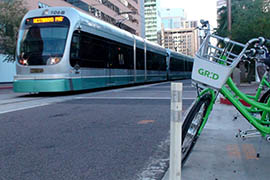Cronkite News has moved to a new home at cronkitenews.azpbs.org. Use this site to search archives from 2011 to May 2015. You can search the new site for current stories.
Going (bright) green: Phoenix getting ready to roll out GRID bike share
PHOENIX – In a city built around the automobile, even a half-mile trip for a cup of coffee can involve driving. But Suzanne Day, Melissa Quillard and Lisa Parks are eager to show a reporter how easily it can be done on a bike.
Specifically, they want to show how it can be done using the Phoenix GRID bike share program that’s expected to launch in late April.
Grabbing bikes from a test rack next to Arizona State University’s Downtown Phoenix Campus, they meander through side streets and cut through an apartment complex parking lot to make the trip faster and safer.
“We could never go this route in a car,” said Day, a business services representative for Valley Metro.
So far there are two other test bike racks set up near Metro light-rail stations, allowing a test group – mostly employees of the city and GRID – to try the bright green bicycles featuring a “:D” emoticon on the baskets and solar-powered panels over the rear tires that allow users to unlock them.
Eventually, there will be 500 bikes stationed around Phoenix, mostly along public transportation routes. For $79 a year – $59 for students – members can use a bike for up to an hour a day, with a charge for use beyond that. Monthly memberships and day passes will also be available.
The long-term goal: complementing public transportation in a way that persuades people to leave their cars at home or at the office. To John Romero, GRID’s director of operations, the bikes provide a “last mile option” to complete trips.
“Even our city planning and design, it exalts the vehicle as a primary form of transportation,” Romero said. “But starting in this downtown and places like Tempe and Mesa, where we have a high density, it’s an introduction to another alternative mode of transportation where we hope it catches on and the system grows.”
For Quillard, who was testing the bike program for the first time, the biggest challenge is getting over the fear of riding alongside motorists.
“I think you have to have some level of ease, just because for people like me who don’t ride all the time it’s intimidating,” she said. “If you don’t do it all the time, it’s a little unnerving. So you have to experience it to realize that it is safe.”
Parks, GRID’s online communications manager, said bikes are great for short trips to and from light rail or lunch for those who work downtown or midtown.
“It gives you a lot more options than if you were just going by foot,” she said.
Romero said the bicycles will also help inform the development of bike lanes. Every GRID bike comes equipped with a GPS system that tracks where each rider takes it. In addition to discouraging theft, that information will show the city and GRID which streets riders are using and avoiding.
“Ours are a bread crumb, a true GPS pathway, and you know exactly where the bike traveled, how far the bike traveled, what routes they took and who took it,” he said.
A smartphone app that riders will use to find and reserve bikes also will tell them how many calories they burned and how much they have helped the environment by reducing greenhouse gas emissions. City officials will be able to measure the same in the aggregate and use it to better accommodate bicycle use, Romero said.
“If you want to have a community that gets out of their car and onto the street and chooses a mode of transport, whether it be a bike or bus, you have to be able to do so in a hospitable way,” he said. “It’s a big city and we’re reverse-engineering 50 years of bad planning.”









